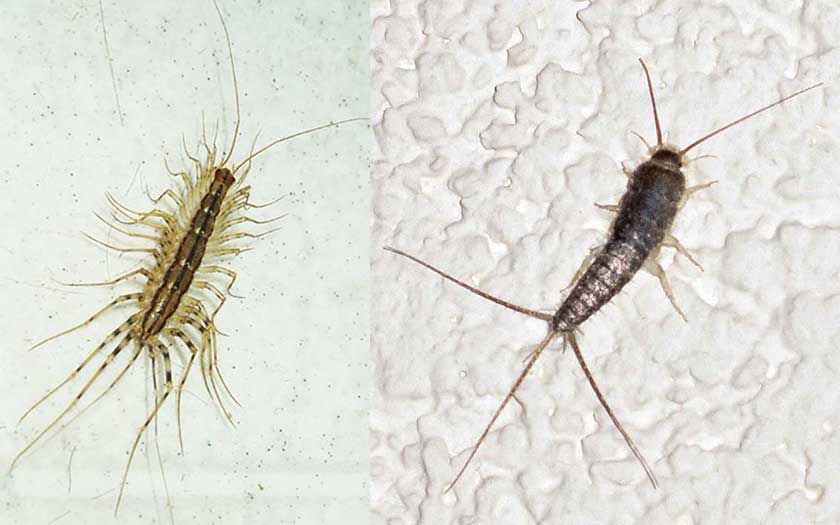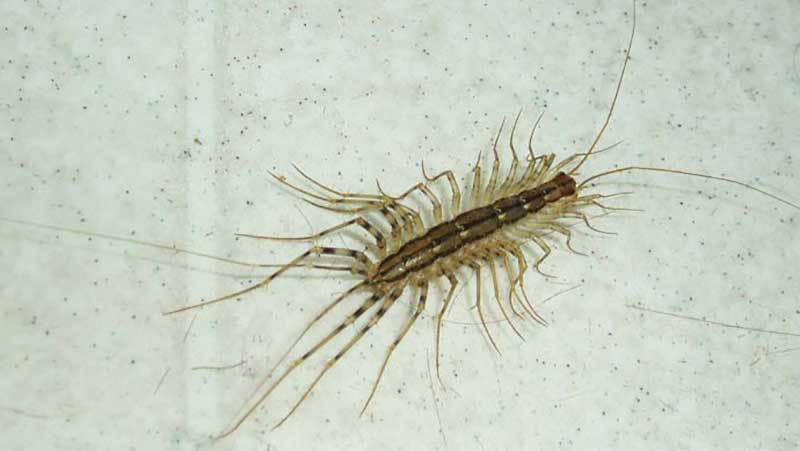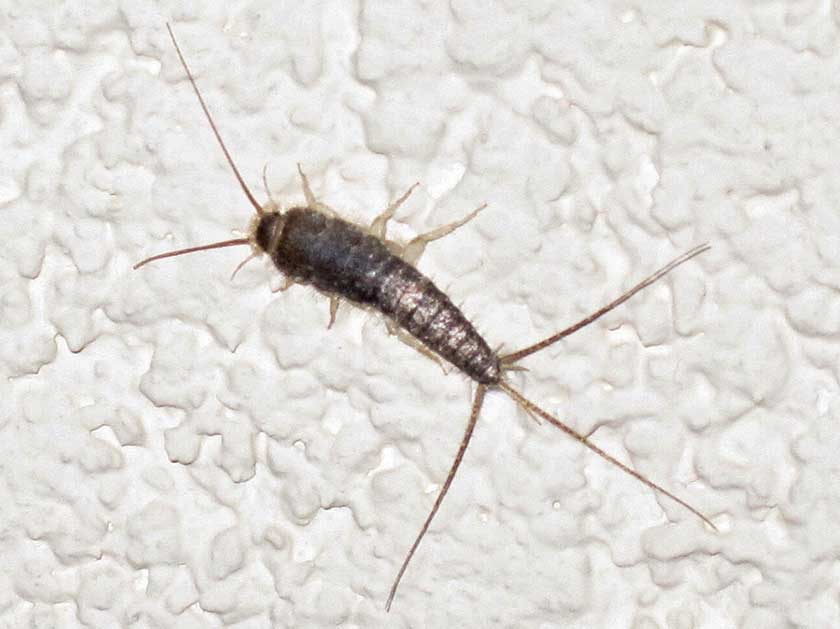In this article, we will discuss the differences between house centipedes and silverfish. These are two very common household pests that many people confuse.

Once you have identified which one is in your home, I recommend checking out my silverfish guide or house centipede guide to learn how to rid your home of these pests.
How to Tell The Difference Between House Centipedes and Silverfish


One of the easiest ways to tell the difference between a silverfish and a house centipede is by looking at the number of legs. House centipedes have way more legs than silverfish (house centipedes typically have around 30 legs, compared to silverfish which only have 6). Female house centipedes also have a rear pair that extends behind them, about twice the length of the torso. It’s these rear legs that cause a lot of confusion because house centipedes have them as well.
Unfortunately, house centipedes can sometimes grow beyond the length of a human palm. These giant variants are less common, but several times as scary. House centipedes are typically a yellow-brown color, and the legs often have dark bands along them.
Silverfish are a gray-silver tone, so there’s another clue for you. Sometimes they are dark brown, but they’ll always be darker than the centipedes.
They are significantly shorter than even male centipedes (a fully matured silverfish is typically under 1 inch long), and their six legs are all pretty short.
Silverfish have two long antennae that pop from the head, and three leg-like appendages jutting from the abdomen. These five extensions are not legs, but sensory apparatuses. The legs and sensory extensions are a light brown tone most of the time.
Related Article: 10 Best Ways to Get Rid of Silverfish
Distinction Of Centipedes vs Silverfish
Once you note the key differences, you’ll see they are actually not too tough to tell apart. Not that anyone wants to stand around looking at them. Centipedes in particular are creepy crawlers, and they bite. Yup.
House Centipedes Key Characteristics
- Typically have 15 pairs of long legs (nearly twice the length of their body)
- Light yellow-brown bodies
- Dark bands running down the torso
- Typically between 1 and 6 inches long
Silverfish Key Characteristics
- Have 6 legs growing from the abdomen
- Shiny silver/gray bodies (occasionally dark brown)
- Two long antenna coming from the head
- Three long feelers extending from the thorax
- Smaller than centipedes
- Fairly soft body
- Typically between 0.5 and a 1 inch long
Related Article: 10 Best Ways to Get Rid of House Centipedes
Differences Centipedes and Silverfish Bite
Here is a key difference between house centipedes and silverfish: Centipedes bite. There are pros and cons here, believe it or not.
Yeah, centipedes bite, but you aren’t going to be rushed to the hospital when it happens. A centipede bite will feel like a bee sting at the absolute worst. They have a tiny bit of venom to dispense, and it’s really meant for messing up their smaller-insect prey.
So unless you’re dealing with some enormous Australian house centipede, a bite is unpleasant, but nothing to worry about. Most bites only happen because someone picks up a house centipede. At that point, you sort of deserve it.
Silverfish, the more proliferative of the two, are thankfully a non-biting species. They might leave chew marks in various foods or other objects, but they don’t bite living organisms. Hey, we’re living organisms! Phew.
Pros and Cons of Infestations
Never thought you’d see this section, did you? Well there are pros and cons to some pest infestations, and we’re going to mention them.
Silverfish infestations aren’t actually beneficial in any noticeable way. Unless you like looking at them or something. After all, silverfish will literally eat your books. Their love for paper is the bane of libraries everywhere.
But house centipedes can be slightly useful! Due to their limiting reproductive habits, house centipedes typically don’t require you to go full Rambo with a pair of insect spray cans. They won’t be very numerous, and you might not even see them.
The real bonus, however, is that they can consume more annoying pests that live in your home. House centipedes are nature’s bug killer, and they will make quick work of little insect pests.
As for the cons to infestation, well, they mean bugs in the house. Yuck.
Centipedes and Silverfish Diets
Silverfish are all about the carbs and the sugars. To be fair, who isn’t?
They’ll also eat paper, various crumbs, dried out bits of food, and other natural fibers. Funny enough, house centipedes actually eat silverfish. That makes centipedes a form of pest control! Personally, we would set the house on fire before bringing house centipedes into it.
House centipedes can actually indicate the presence of other bugs in the home too. They feast on other buggies like spiders, bedbugs, and termites.
Oh, and roaches. Yes, house centipedes prey on everyone’s favorite insectoid armageddon survivors. We wish we could actually recommend machine guns as pest control in this case.
At least with house centipedes, your food is safe. They are strictly bug eaters.
Centipedes and Silverfish Habitat
Damp, moist areas will allow both species to invade and take over your home.
You may not notice a centipede/silverfish infestation right away. They are both nocturnal, so you will probably be resting in bed while they scuttle around your dark house.
If you flip on a light, they will both scurry very quickly. House centipedes and silverfish are really fast, so watch out!
Warmth will attract them as well, and centipedes in particular. They don’t do well in very cold temperatures, so turn down that thermostat. The bathroom is probably the most common place for both house centipedes and silverfish to hang out.
They can crawl into your faucets, behind the toilet, under the sink, or anywhere else that is wet and fit for partying. Silverfish in particular like tight spaces. Dark corners, little closed-in areas between the stove and the kitchen drawers, or behind piles of boxes in the garage.
Centipedes and Silverfish Eggs
Both silverfish and centipedes lay eggs, but that’s where the similarities end.
House centipedes are less proactive, laying only about 35 eggs during spring and summer. The males eject sperm onto the ground for some lucky girl to find and use for impregnation. Sort of takes the fun out of things.
House centipede eggs are typically laid in damp soil, so unless you have a really desperate lady centipede or a bunch of wet soil in your house (we’re looking at you, Dracula), they probably won’t reproduce indoors.
The eggs are round and globular, usually slightly yellowish in tone.
Silverfish are the worst offenders here, laying about 60 eggs… Per day. And they don’t need moist dirt to do it either. Your kitchen floor looks just fine, as a matter of fact. Silverfish also produce pheromones that attract other silverfish.
Where there were some, now there are more.
You can see why these things are considered pests. So how do you locate these eggs? Well, they are first soft and white when produced. Like ultra-tiny hard-boiled eggs, only you won’t like what’s inside.
As time goes on, they become hardened and yellow. They are almost elliptical, so look more for ovals, not spheres. These things will be snug inside little cracks, dark places, and other locations that are difficult to reach. Female silverfish really win mother-of-the-year awards here–those eggs are tough to get to.
But they may also be buried in dust, food, clothing, and other fun spots. This being the case, if you know you have an infestation, keep your laundry regularly done and your food safe. Once you actually see silverfish hustling around, check for nearby eggs.
Prevention of Centipedes and Silverfish
A good defense is important. For silverfish, you’re looking at minimizing your cardboard box content. Silverfish will feast on the paper content. If you have a bunch of cardboard boxes in an attic, consider exchanging them for plastic tubs. And always wash out any container you bring into the home, just in case it was previously occupied by some unknown pest.
Also, try scanning your house for cracks and crevices. Caulk is a simple way to seal those cracks up and stop silverfish from turning your home into egg city.
As for centipedes, getting rid of silverfish is, itself, an anti-house centipede tactic! Deprive them of the their food source and you’re on the right track. Also, clear the area outside your home of debris, like wet leaves and similar moist nesting locations.
But you can help prevent centipedes and silverfish by keeping your home dry. Try a dehumidifier, for example. Shower steam should be minimized with a good bathroom fan as well.
If you have a wood-burning furnace, it is best to store your wood fuel outside, especially if it is damp. Centipedes in particular like to nest in wood.
Frequently Asked Questions
Can I Kill Centipedes and Silverfish with the Same products?
You sure can.
Insect killers like boric acid, diatomaceous earth, cyfluthrin solutions, and sticky traps can all be used to kill off house centipedes and silverfish. The two species may be different, but when it comes to removal options, many of the same materials will work just fine.
Which is Worse Centipedes and Silverfish?
The answer is almost unequivocally that silverfish are the worse pest. They are more numerous, they eat your paper, and they reproduce in large numbers within your home. While they don’t pose any physical threats, you are more likely to have a silverfish creep up your arm when you’re sitting on the couch.
Centipedes may look scarier, but they tend not to reproduce in the numbers necessary to cause serious problems. Unless you really allow your home to get damp and out of control, house centipedes will prefer to hang outside.
If centipedes run out of other pests to devour, they’ll need to go elsewhere. Since they only subsist on other insects, their presence is actually a kind of helpful alarm. Now You Know!
That wraps up the chief differences between house centipedes and silverfish. Now that you know the difference, it’s up to you to move forward on your pest control projects. And don’t go picking up any house centipedes unless you enjoy minorly venomous love bites.
How do you Get Rid of Centipedes and Silverfish?
You want to expel centipedes and silverfish from the house. We can help with that. Just know, it’s not a one-size-fits-all situation though. Once you know which insect is infesting your home, you can then use products to specifically target that pest.
We actually have guides on how to get rid of both of these pets. I provided a link to them at the top of the page you can use, or you can simply use the search box on our website to find them.
Related Article: 9 Best Ways to Get Rid of Spiders
My name is Blane and I’m a life-long resident of Southeastern Louisiana. I’ve been working as Pest Control Technician and Inspector for about 1.5 years now.
I’ve worked in many other industries as well, including consulting, managing, as well as at the ground level in fields including Food Service, Corporate Automotive sales, and finance. Whether it be providing counsel, content, or hands-on support; my goal remains to add value to the lives of the people I serve.
If you have any questions regarding pest control, leave them below. I would be happy to help you out in any way I can.
